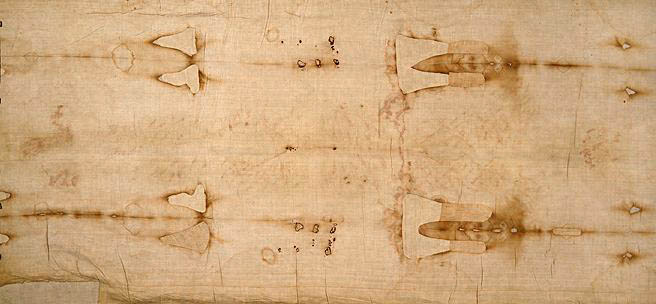
Note the slightly grayish area in the neck and down the back... the queue braid blurry probably because of oil or grease.
Posted on 10/05/2009 6:17:42 PM PDT by JoeProBono
Scientists have reproduced the Shroud of Turin — revered as the cloth that covered Jesus in the tomb — and say the experiment proves the relic was man-made, a group of Italian debunkers claimed Monday
The shroud bears the figure of a crucified man, complete with blood seeping out of nailed hands and feet, and believers say Christ's image was recorded on the linen fibers at the time of his resurrection.
Scientists have reproduced the shroud using materials and methods that were available in the 14th century, the Italian Committee for Checking Claims on the Paranormal said.
The group said in a statement this is further evidence the shroud is a medieval forgery. In 1988, scientists used radiocarbon dating to determine it was made in the 13th or 14th century......
(Excerpt) Read more at sfgate.com ...
No, actually Linen is very tough material. It was not uncommon for linen bed clothes to last for generations. Often the linens were major portions of the inheritance of a family's wealth. This was when a single bed sheet could represent the hard work of several tradesmen, growers, spinners, fullers, weavers, dyers, bleachers. A cloth like the Shroud, over 14 feet long, woven on a wall loom, could take a skilled weaver several weeks worth of labor to create.
Thanks for the ping, Swordmaker.
Works of art do not exist in a vacuum, an island unto themselves. They always show signs of similar works of the period. The image on the Shroud bears absolutely no similarities to other works of the Centuries surrounding the proposed creation dates of 1290 to 1360 AD. If it is a work of art, then there would be other similar examples. There aren't. In fact, the entire shroud flies in the face of the sensibilities of the times where in Art, Jesus was never shown nude.
In household use true; I am thinking of a scenario where exposed to mold and mildew. For example the way the prophet Ezekiel (iirc without checking the bible first) got a linen sash or belt, then stowed it at God’s direction in the rocks by a river. Later he was told to go fetch it, and the way it had been ruined was used by God as an example of how Israel had become useless to Him.
Nope. He thought of naked ladies... just as Edison turned out some movies of naked ladies. Pornography predates almost all other uses of still photography and motion pictures.
Best case measurement is 5' 10 1/4", not even one sigma away from the average height of mature male skeletons surveyed in 1st Century Jewish cemeteries, 5' 8 3/8". To put that in perspective, the average 21st Century American male is 5' 8 1/2"
It's been address before... even here on FreeRepublic. I know because I addressed it. The braid was also kept oiled...
There are very few molds or mildews that attack Linen being almost pure cellulose... but it can be destroyed by the exudates from rotting bodies. Linen was the choice for sail cloth because of this ability to resist mildew and mold... but it will still rot eventually.
Anyhow, the point was that if linen were lost in a crumbled structure or among rocks, it wouldn’t stick around all that long. One of nature’s answers to biodegrading cellulose is insects (e.g. termites or perhaps more properly the micro-organisms that live in the guts of termites, without which the cellulose they eat would do them no more good than so much inert material).
An oiled braid... wouldn’t that create a grease spot if this were an actual area of contact?
That's a good modality for Linen destruction.
Yes... the mostly undone queue that runs down the back of the neck and onto the shoulders of the image on the Man on the Shroud is slightly blurred compared to other image areas and hair images, probably because of the oils exuding from the queue onto the cloth. Any oil that was there has long since evaporated.

Note the slightly grayish area in the neck and down the back... the queue braid blurry probably because of oil or grease.
Thinking of what type of oil would be involved.
If a hydrocarbon oil, that would indeed literally evaporate after so much time. The rate is slow after the carbon count goes over a couple dozen, but it’s not as though this happened yesterday.
If something like olive oil or seed oils, perhaps biodegradation by microbes eventually took care of it.
Source, please?
His burial was hurried; Passover was fast approaching. He was somewhat cleaned up after being taken down from the cross, taken to a tomb, laid on a fine linen shroud that was probably donated by Joseph of Arimathea (wealthiest man in the region and a devoted follower of Jesus); the remainder of the shroud merely folded back over him; no wrapping. The idea was to return after Passover, three days later, and “finish” a proper burial process. However....we know what they found...
As for the head cloth, you are correct. The purported head cloth of Christ is the Sudarium, located in Oviedo, Spain. It was placed over His head after He died on the cross; to cover His face....sort of a vanity kind of thing.
The man in the Shroud image was definitely Semitic; early-to-mid 30’s, around 6’ tall.
Except that the apostles were able to recognize him and before knowing it was Christ, a human form.
Thank you for the ping.
And a bump.
Disclaimer: Opinions posted on Free Republic are those of the individual posters and do not necessarily represent the opinion of Free Republic or its management. All materials posted herein are protected by copyright law and the exemption for fair use of copyrighted works.